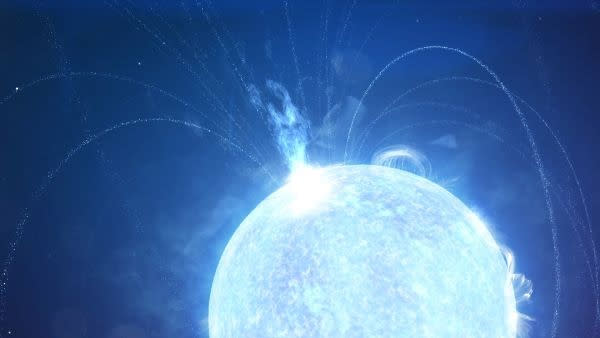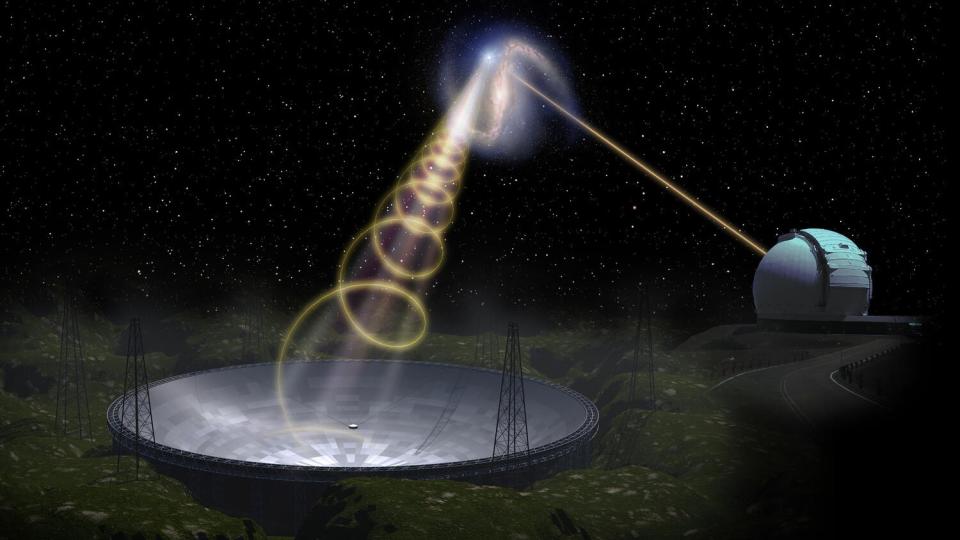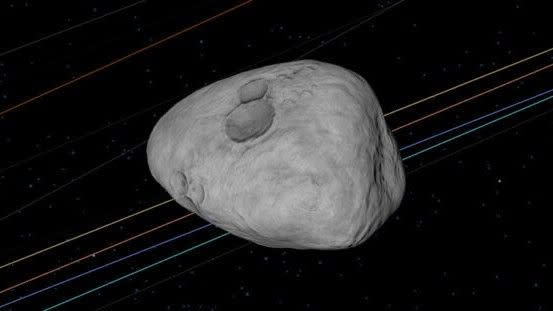Scientists discover 'glitched' neutron star that obliterated an asteroid, then fired off a brilliant explosion

A rapidly spinning neutron star with an incredibly powerful magnetic field "glitched" when it destroyed a space rock, a new study suggests.
The neutron star SGR 1935+2154, which is located an estimated 30,000 light-years away near the center of the Milky Way, appeared to "glitch" by very briefly changing its rational speed after an asteroid was pulled in by its gravity and ripped apart. The glitch consisted of the star changing its rotational speed while also releasing a fast radio burst (FRB), a powerful blast of radio waves.
In a new study of the "glitched" star, astronomers can finally connect these mysterious bursts of radio energy to these extreme star corpses known as magnetars.
Related: A new approach might help scientists see inside a neutron star
Like all neutron stars, magnetars are born when a massive star runs out of fuel for nuclear fusion — a process that creates the outward energy needed to stop a star from collapsing under its own gravity.
As the outer layers of the star are blown apart by a powerful supernova or star explosion, the inner core collapses, birthing a stellar remnant with the mass of the sun squeezed into a width equivalent to the average city on Earth. (One teaspoon of neutron star matter brought to Earth would therefore weigh 1 billion tons.)
The collapse also pushes together the magnetic field lines of the dying star, creating the universe's most powerful magnetic fields. Hence, this type of neutron star boasting a powerful magnetic field is known as a magnetar.

FRBs, meanwhile, have been something of a puzzle since the first, the Lorimer Burst, was spotted in 2007. These radio pulses, with durations from a fraction of a millisecond to three seconds that very rarely repeat, were first connected to magnetars back in 2020 when astronomers spotted two rapid-fire FRBs coming from within the Milky Way.
Though the connection between magnetars and FRBs was established, scientists still weren't clear what this mechanism behind the link actually was.

The new study implies that magnetars could produce FRBs when their immense gravitational influence generates tremendous tidal forces in an asteroid so tremendous that the space rock is ripped apart. (The same effect is seen around black holes in tidal disruption events; when a star gets too close to the cosmic titan, its gravitational influence shreds the star.)
Because neutron stars are essentially the remains of dead stars, it is feasible that they are surrounded by the remains of their planetary systems. If these zones are anything like our solar system, this debris would include asteroids.
If an asteroid is pulled in by a magnetar's gravity and destroyed, the momentum the space rock carries with it through its dead planetary system can't likewise be obliterated due to the laws of physics. The glitch in the magnetar's speed would thus arise from the momentum carried by the asteroid being transferred to the magnetar.
If the asteroid is racing in the same direction as the neutron star spins, this action speeds the rotation of the dense stellar remnant up — a "glitch." If the asteroid was traveling in the opposite direction to the spin of the magnetar, the transferred angular momentum slows its rotation, which is classed as an "anti-glitch."
The remains of the destroyed asteroid are subsequently ensnared by the intense magnetic field of the magnetar, causing the field lines to tangle, snap and reconnect. This process, called magnetic reconnection, blasts out the FRB.

RELATED STORIES:
— James Webb Space Telescope spots violent collision between neutron stars
— City-size neutron stars may actually be bigger than we thought
— The heaviest neutron star ever observed is shredding its companion
Eventually, what remains of the space rock will fall to the surface of the neutron star. The gravity of one of these stellar remnants is so great that an object with the mass of a marshmallow falling to its surface would release the energy equivalent to the detonation of 1,000 hydrogen bombs, according to NASA.
This means asteroid material hitting the surface of the neutron star should create powerful flares of energy in different frequencies of light, which could be spotted by astronomers. Scientists tuned to this effect could help find more asteroids being savaged by magnetars, thus further strengthening the connection between these neutron stars and the destructive events they cause to create FRBs.
The team's research was published May 25 in the peer-reviewed Monthly Notices of the Royal Astronomical Society.

